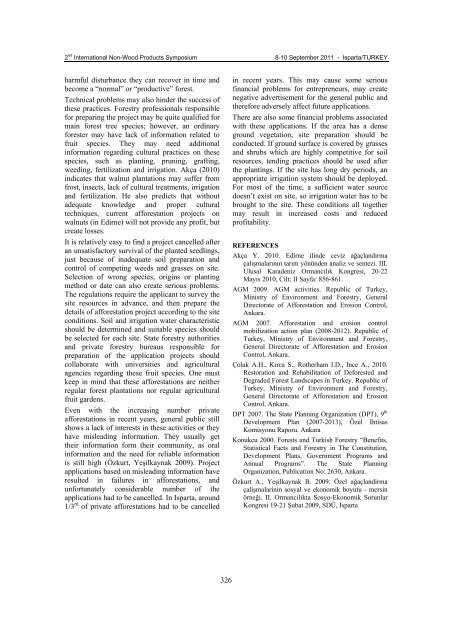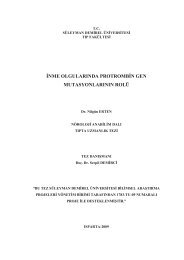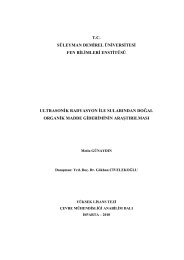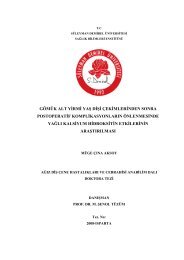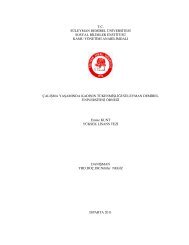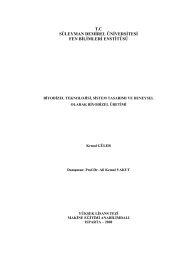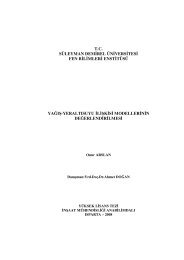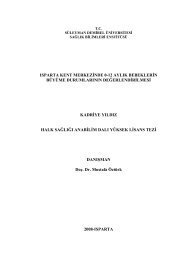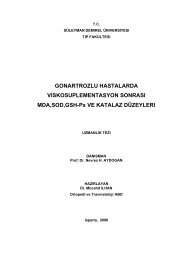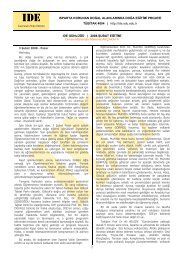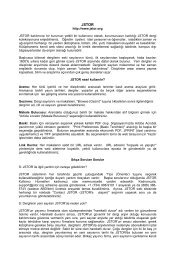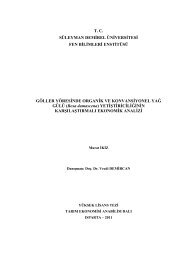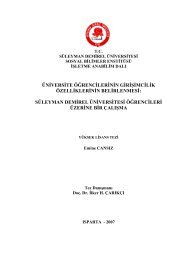Proceedings Book / Bildiri Kitabı - Orman Fakültesi - Süleyman ...
Proceedings Book / Bildiri Kitabı - Orman Fakültesi - Süleyman ...
Proceedings Book / Bildiri Kitabı - Orman Fakültesi - Süleyman ...
You also want an ePaper? Increase the reach of your titles
YUMPU automatically turns print PDFs into web optimized ePapers that Google loves.
2 nd International Non-Wood Products Symposium 8-10 September 2011 - Isparta/TURKEY<br />
harmful disturbance they can recover in time and<br />
become a “normal” or “productive” forest.<br />
Technical problems may also hinder the success of<br />
these practices. Forestry professionals responsible<br />
for preparing the project may be quite qualified for<br />
main forest tree species; however, an ordinary<br />
forester may have lack of information related to<br />
fruit species. They may need additional<br />
information regarding cultural practices on these<br />
species, such as planting, pruning, grafting,<br />
weeding, fertilization and irrigation. Akça (2010)<br />
indicates that walnut plantations may suffer from<br />
frost, insects, lack of cultural treatments, irrigation<br />
and fertilization. He also predicts that without<br />
adequate knowledge and proper cultural<br />
techniques, current afforestation projects on<br />
walnuts (in Edirne) will not provide any profit, but<br />
create losses.<br />
It is relatively easy to find a project cancelled after<br />
an unsatisfactory survival of the planted seedlings,<br />
just because of inadequate soil preparation and<br />
control of competing weeds and grasses on site.<br />
Selection of wrong species, origins or planting<br />
method or date can also create serious problems.<br />
The regulations require the applicant to survey the<br />
site resources in advance, and then prepare the<br />
details of afforestation project according to the site<br />
conditions. Soil and irrigation water characteristic<br />
should be determined and suitable species should<br />
be selected for each site. State forestry authorities<br />
and private forestry bureaus responsible for<br />
preparation of the application projects should<br />
collaborate with universities and agricultural<br />
agencies regarding these fruit species. One must<br />
keep in mind that these afforestations are neither<br />
regular forest plantations nor regular agricultural<br />
fruit gardens.<br />
Even with the increasing number private<br />
afforestations in recent years, general public still<br />
shows a lack of interests in these activities or they<br />
have misleading information. They usually get<br />
their information form their community, as oral<br />
information and the need for reliable information<br />
is still high (Özkurt, Yeşilkaynak 2009). Project<br />
applications based on misleading information have<br />
resulted in failures in afforestations, and<br />
unfortunately considerable number of the<br />
applications had to be cancelled. In Isparta, around<br />
1/3 rd of private afforestations had to be cancelled<br />
in recent years. This may cause some serious<br />
financial problems for entrepreneurs, may create<br />
negative advertisement for the general public and<br />
therefore adversely affect future applications.<br />
There are also some financial problems associated<br />
with these applications. If the area has a dense<br />
ground vegetation, site preparation should be<br />
conducted. If ground surface is covered by grasses<br />
and shrubs which are highly competitive for soil<br />
resources, tending practices should be used after<br />
the plantings. If the site has long dry periods, an<br />
appropriate irrigation system should be deployed.<br />
For most of the time, a sufficient water source<br />
doesn’t exist on site, so irrigation water has to be<br />
brought to the site. These conditions all together<br />
may result in increased costs and reduced<br />
profitability.<br />
REFERENCES<br />
Akça Y. 2010. Edirne ilinde ceviz ağaçlandırma<br />
çalışmalarının tarım yönünden analiz ve sentezi. III.<br />
Ulusal Karadeniz <strong>Orman</strong>cılık Kongresi, 20-22<br />
Mayıs 2010, Cilt: II Sayfa: 856-861.<br />
AGM 2009. AGM activities. Republic of Turkey,<br />
Ministry of Environment and Forestry, General<br />
Directorate of Afforestation and Erosion Control,<br />
Ankara.<br />
AGM 2007. Afforestation and erosion control<br />
mobilization action plan (2008-2012). Republic of<br />
Turkey, Ministry of Environment and Forestry,<br />
General Directorate of Afforestation and Erosion<br />
Control, Ankara.<br />
Çolak A.H., Kırca S., Rotherham I.D., Ince A., 2010.<br />
Restoration and Rehabilitation of Deforested and<br />
Degraded Forest Landscapes in Turkey. Republic of<br />
Turkey, Ministry of Environment and Forestry,<br />
General Directorate of Afforestation and Erosion<br />
Control, Ankara.<br />
DPT 2007. The State Planning Organization (DPT), 9 th<br />
Development Plan (2007-2013), Özel Ihtisas<br />
Komisyonu Raporu. Ankara<br />
Konukcu 2000. Forests and Turkish Forestry “Benefits,<br />
Statistical Facts and Forestry in The Constitution,<br />
Development Plans, Government Programs and<br />
Annual Programs”. The State Planning<br />
Organization, Publication No: 2630, Ankara.<br />
Özkurt A., Yeşilkaynak B. 2009. Özel ağaçlandirma<br />
çalişmalarinin sosyal ve ekonomik boyutu - mersin<br />
örneği. II. <strong>Orman</strong>cilikta Sosyo-Ekonomik Sorunlar<br />
Kongresi 19-21 Şubat 2009, SDÜ, Isparta<br />
326


